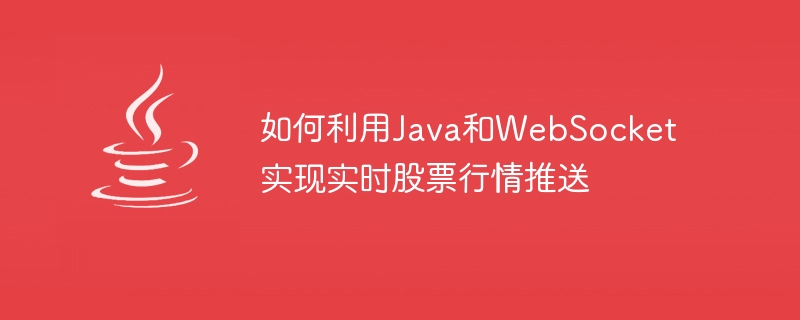Home >Java >javaTutorial >How to use Java and WebSocket to implement real-time stock quotation push
How to use Java and WebSocket to implement real-time stock quotation push
- WBOYWBOYWBOYWBOYWBOYWBOYWBOYWBOYWBOYWBOYWBOYWBOYWBOriginal
- 2023-12-17 21:15:301622browse

How to use Java and WebSocket to implement real-time stock quotation push
Introduction:
With the rapid development of the Internet, real-time stock quotation push has become a concern of investors One of the focal points. The traditional stock market push method has problems such as high delay and slow refresh speed. For investors, the inability to obtain the latest stock market information in a timely manner may lead to errors in investment decisions. Real-time stock quotation push based on Java and WebSocket can effectively solve this problem, allowing investors to obtain the latest stock quotation information as soon as possible, improving investment efficiency and decision-making accuracy.
This article will focus on how to use Java and WebSocket to implement real-time stock quotation push, and give specific code examples at the technical level to help readers quickly get started and understand.
1. Introduction to WebSocket
WebSocket is a protocol for full-duplex communication on a single TCP connection, which can achieve real-time two-way communication. Compared with traditional HTTP requests, WebSocket has lower latency, higher communication efficiency and real-time performance. At the same time, WebSocket has good compatibility in various browsers and can be widely used in the field of web development.
2. WebSocket implementation in Java
In Java, we can use the WebSocket standard in the Java API to implement the WebSocket function. Java API provides simple and easy-to-use interfaces and classes to facilitate our WebSocket development.
- Creating a WebSocket server
To implement the WebSocket function, you first need to create a WebSocket server to listen for client connection requests and create a WebSocket session for each connection.
The following is a simple Java code example that demonstrates how to create a WebSocket server and listen for client connection requests.
import javax.websocket.*;
import javax.websocket.server.ServerEndpoint;
@ServerEndpoint("/stock")
public class StockWebSocketServer {
@OnOpen
public void onOpen(Session session) {
// 新的连接建立时的操作
}
@OnMessage
public void onMessage(String message, Session session) {
// 接收到客户端消息时的操作
}
@OnClose
public void onClose(Session session) {
// 连接关闭时的操作
}
@OnError
public void onError(Throwable error) {
// 发生错误时的操作
}
}The above code defines the address of the WebSocket server through the @ServerEndpoint annotation, where /stock is the URL address of the WebSocket. Next, we can write corresponding logic processing in the methods annotated with @OnOpen, @OnMessage, @OnClose and @OnError .
- Send real-time stock quotation data
When new stock quotation data is generated, we can send it to the client through WebSocket.
The following is a sample code that demonstrates how to send real-time stock quotation data to the client:
import javax.websocket.*;
import javax.websocket.server.ServerEndpoint;
@ServerEndpoint("/stock")
public class StockWebSocketServer {
private Map<Session, Boolean> clients = new ConcurrentHashMap<>();
@OnOpen
public void onOpen(Session session) {
clients.put(session, true);
}
@OnClose
public void onClose(Session session) {
clients.remove(session);
}
public void sendStockData(String data) {
for (Session session : clients.keySet()) {
try {
session.getBasicRemote().sendText(data);
} catch (IOException e) {
e.printStackTrace();
}
}
}
}In the above code, clients is a A collection of WebSocket sessions. In the onOpen method, when a new connection is established, a new session is added to clients; in the onClose method, when the connection is closed, Remove the session from clients. The
sendStockData method is used to send real-time stock quotes data to all clients by traversing the clients collection and calling session.getBasicRemote().sendText(data ) method to send data. It is worth noting that in practical applications, the acquisition of stock market data should be determined based on actual needs.
- Client code example
Finally, we also need to write client code to connect to the WebSocket server and receive real-time stock quotes data.
The following is a simple JavaScript code example that demonstrates how to connect to a WebSocket server and receive real-time stock quotes data.
var socket = new WebSocket("ws://localhost:8080/stock");
socket.onopen = function() {
console.log("WebSocket连接已建立");
};
socket.onmessage = function(event) {
var data = event.data;
console.log("接收到实时股票行情数据:" + data);
};
socket.onclose = function() {
console.log("WebSocket连接已关闭");
};The above code creates a WebSocket object through new WebSocket("ws://localhost:8080/stock") and connects to the specified URL address. In the onopen event, you can add logical processing to implement operations after the connection is established. In the onmessage event, you can write logic to process the received real-time stock quote data. Finally, in the onclose event, you can add logic processing to implement operations after the connection is closed.
Conclusion:
Through the introduction of this article, we can learn how to use Java and WebSocket to achieve real-time stock quotation push. We first create a WebSocket server to listen to the client's connection request and define the corresponding logic processing; then, send real-time stock quotation data to the client through the WebSocket server; finally, the client creates a WebSocket connection and receives the real-time stock quotation sent by the server. data.
WebSocket technology has low latency and high real-time performance, which can provide better user experience and investment results for real-time stock quotation push. By using Java to develop WebSocket servers and clients, we can more easily implement the real-time stock quotation push function and expand and optimize it accordingly for specific application needs. I hope the introduction in this article can be helpful to readers in actual development.
The above is the detailed content of How to use Java and WebSocket to implement real-time stock quotation push. For more information, please follow other related articles on the PHP Chinese website!

